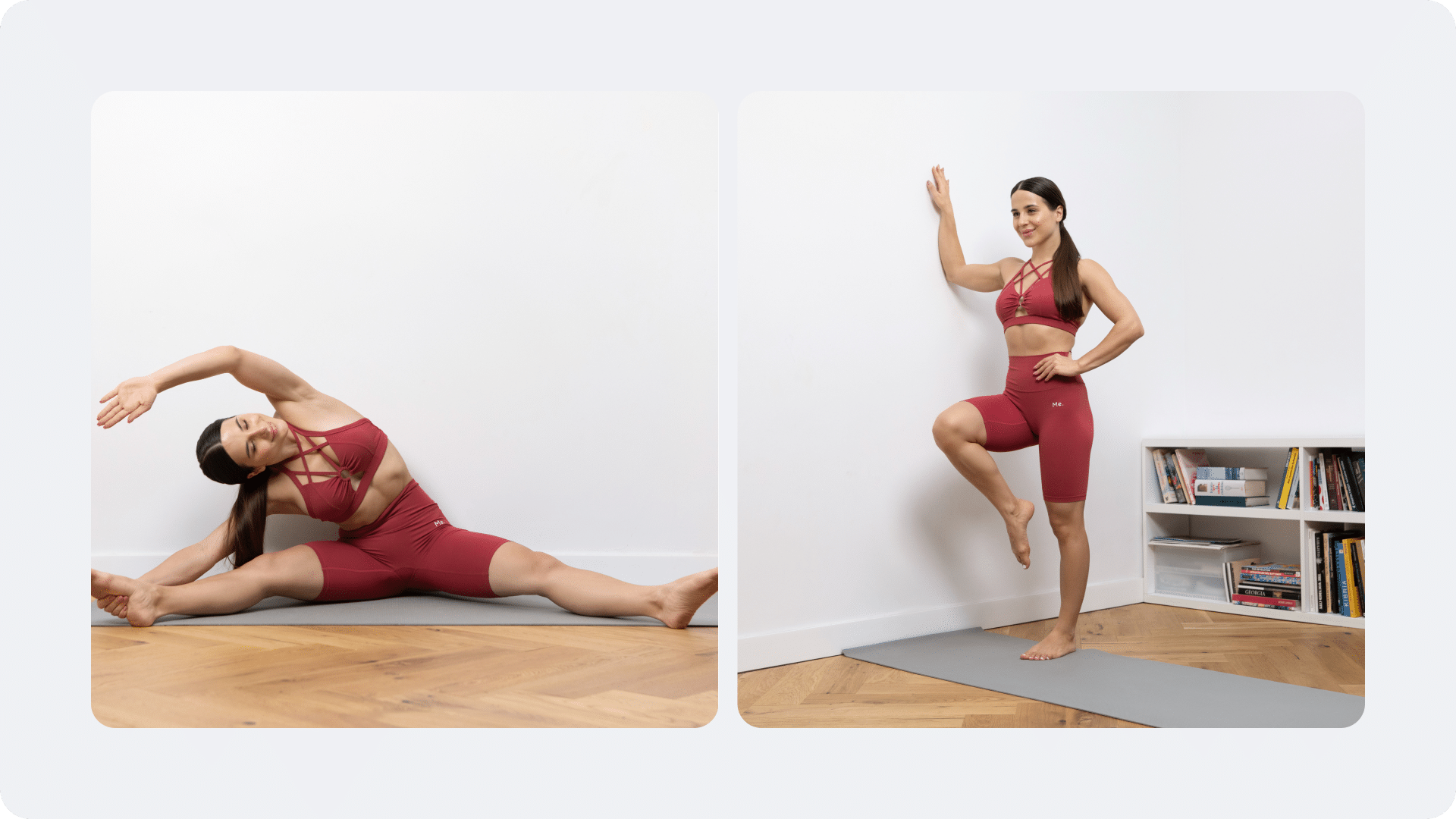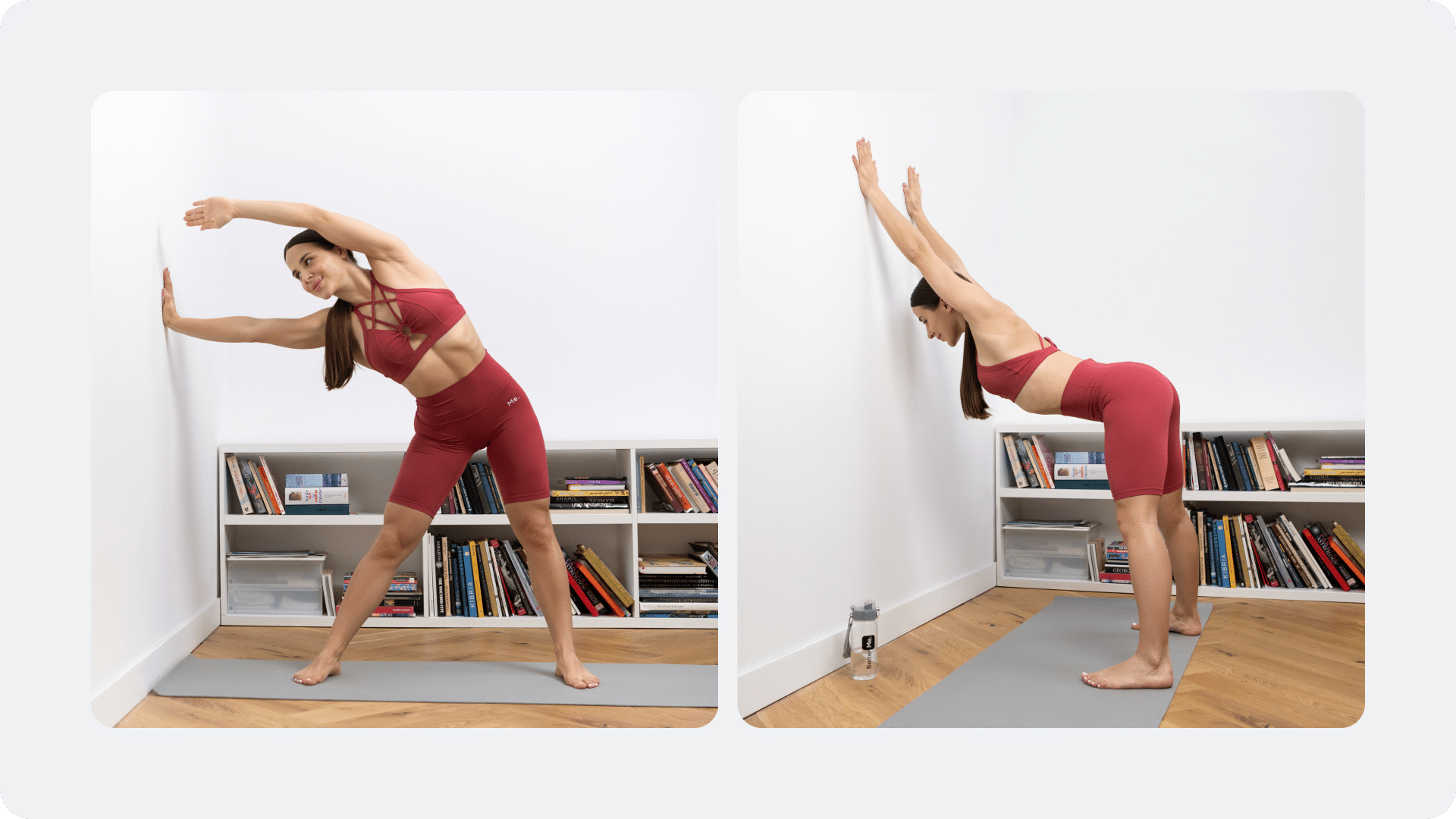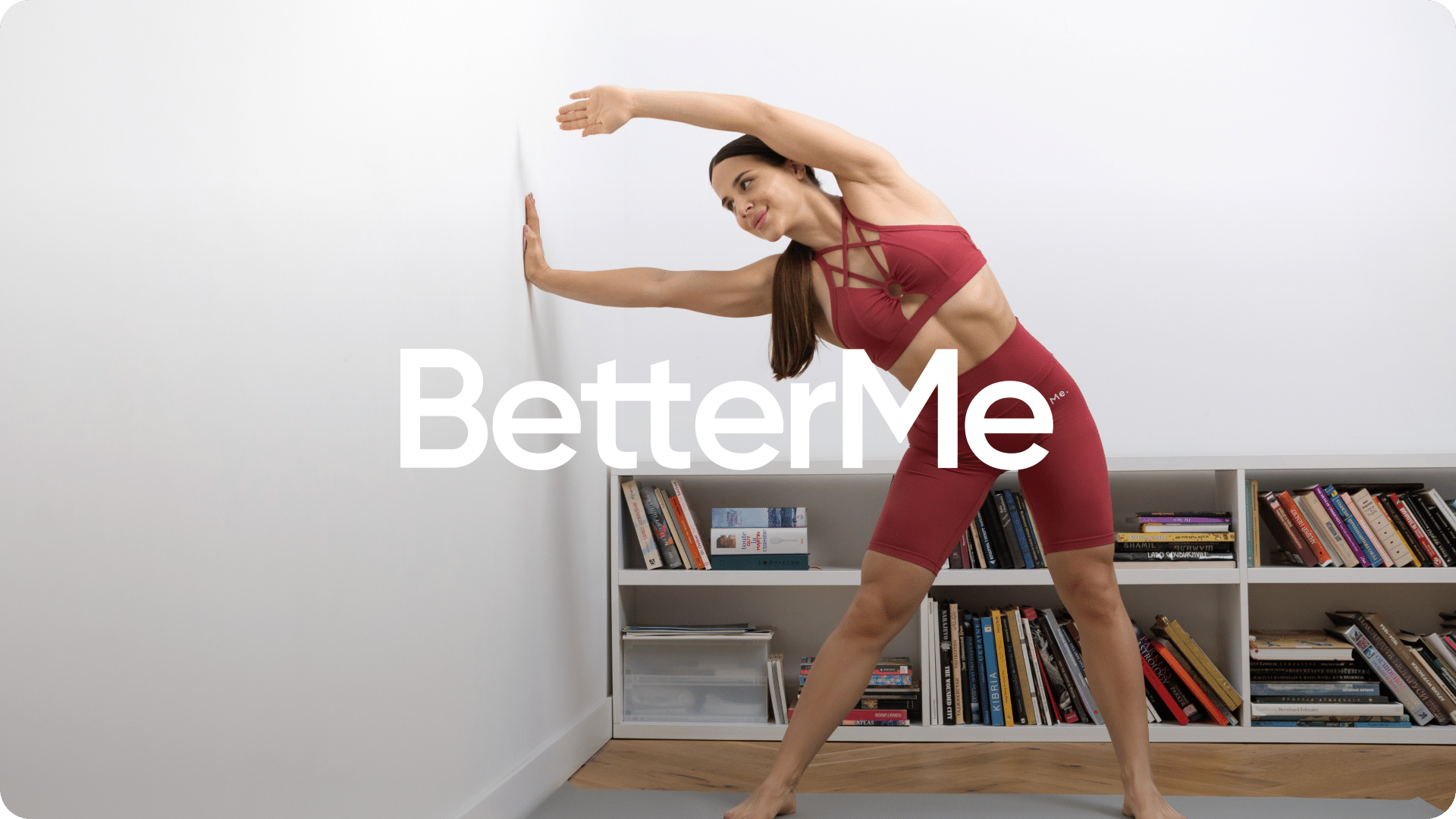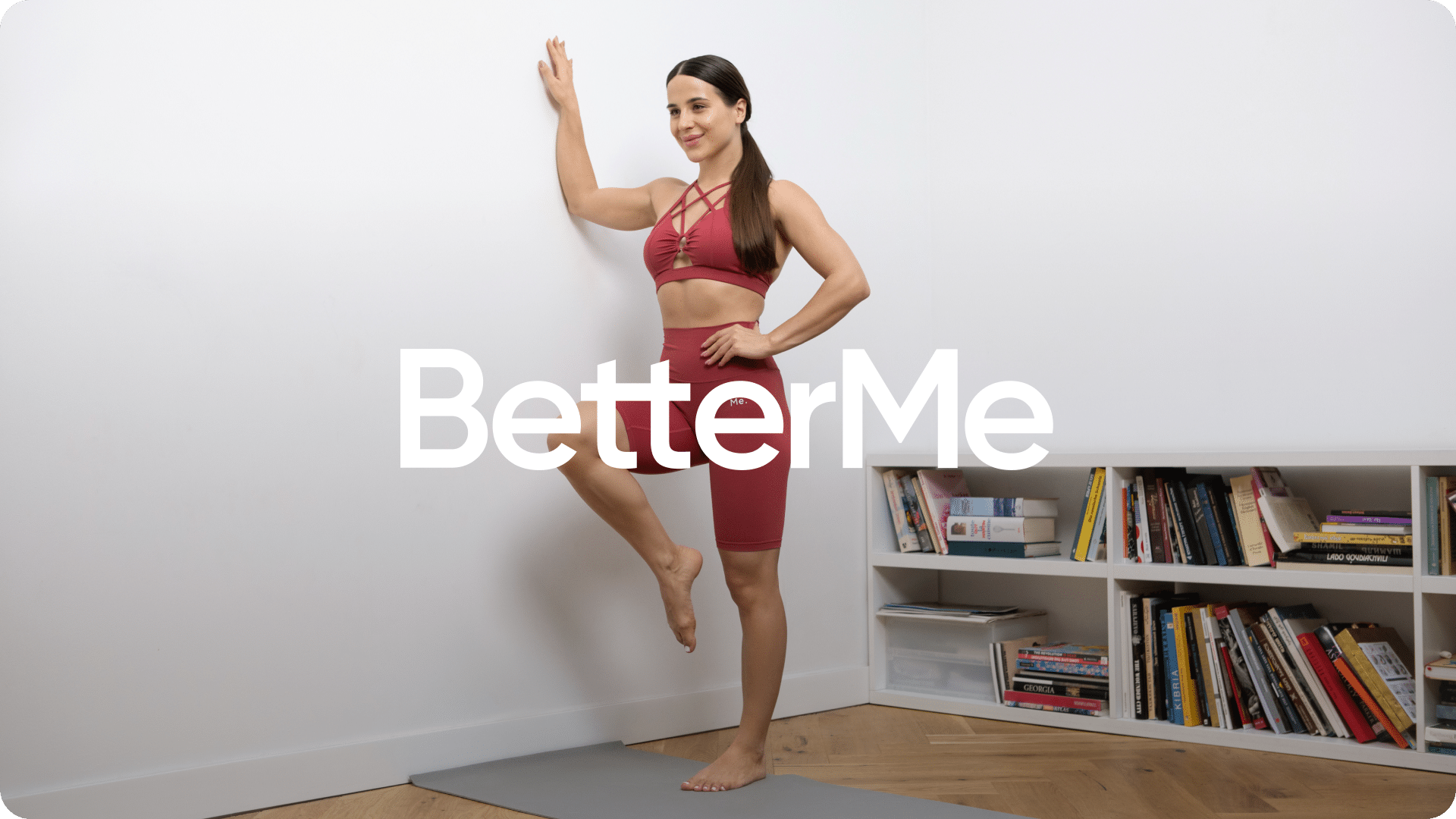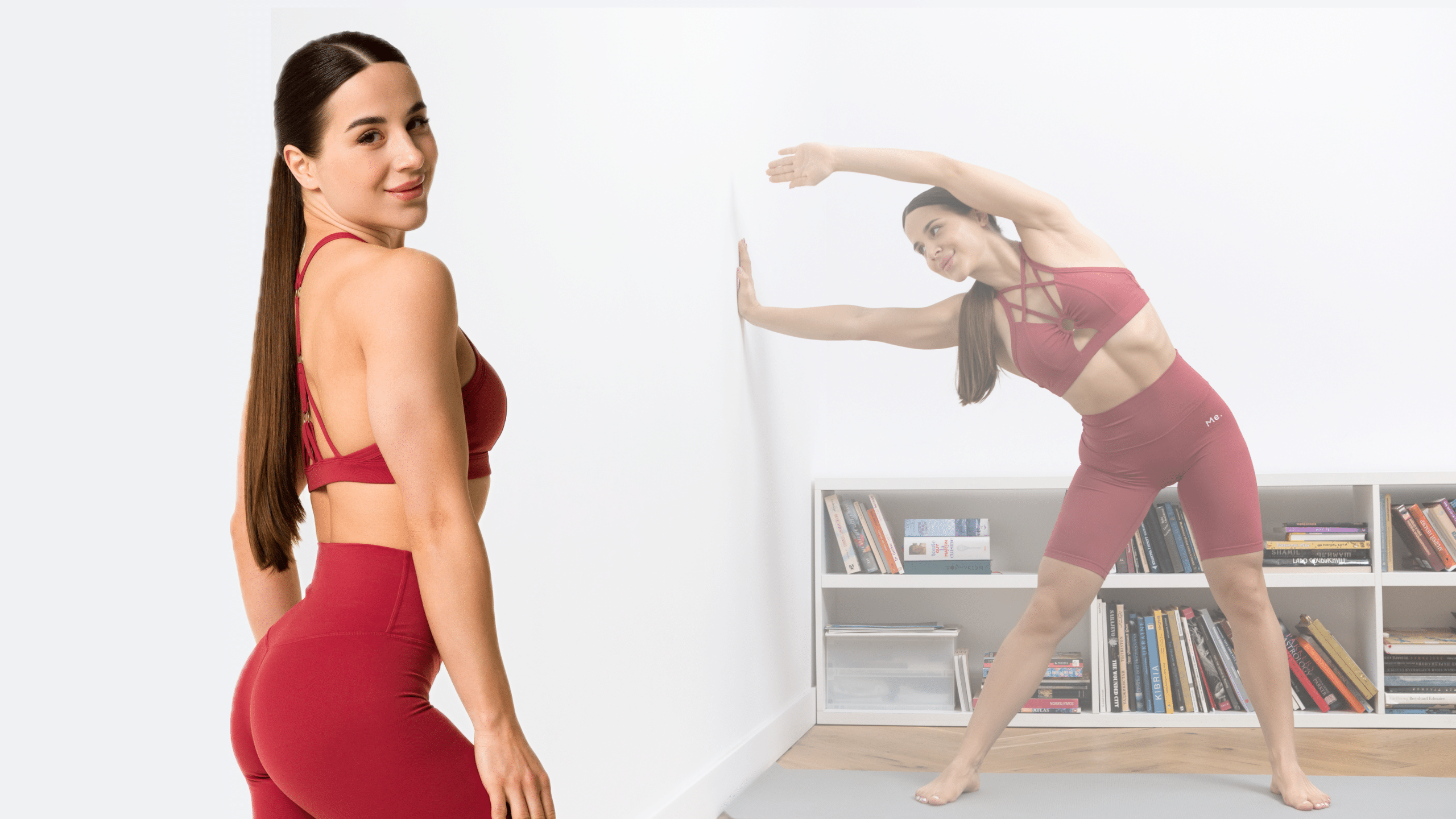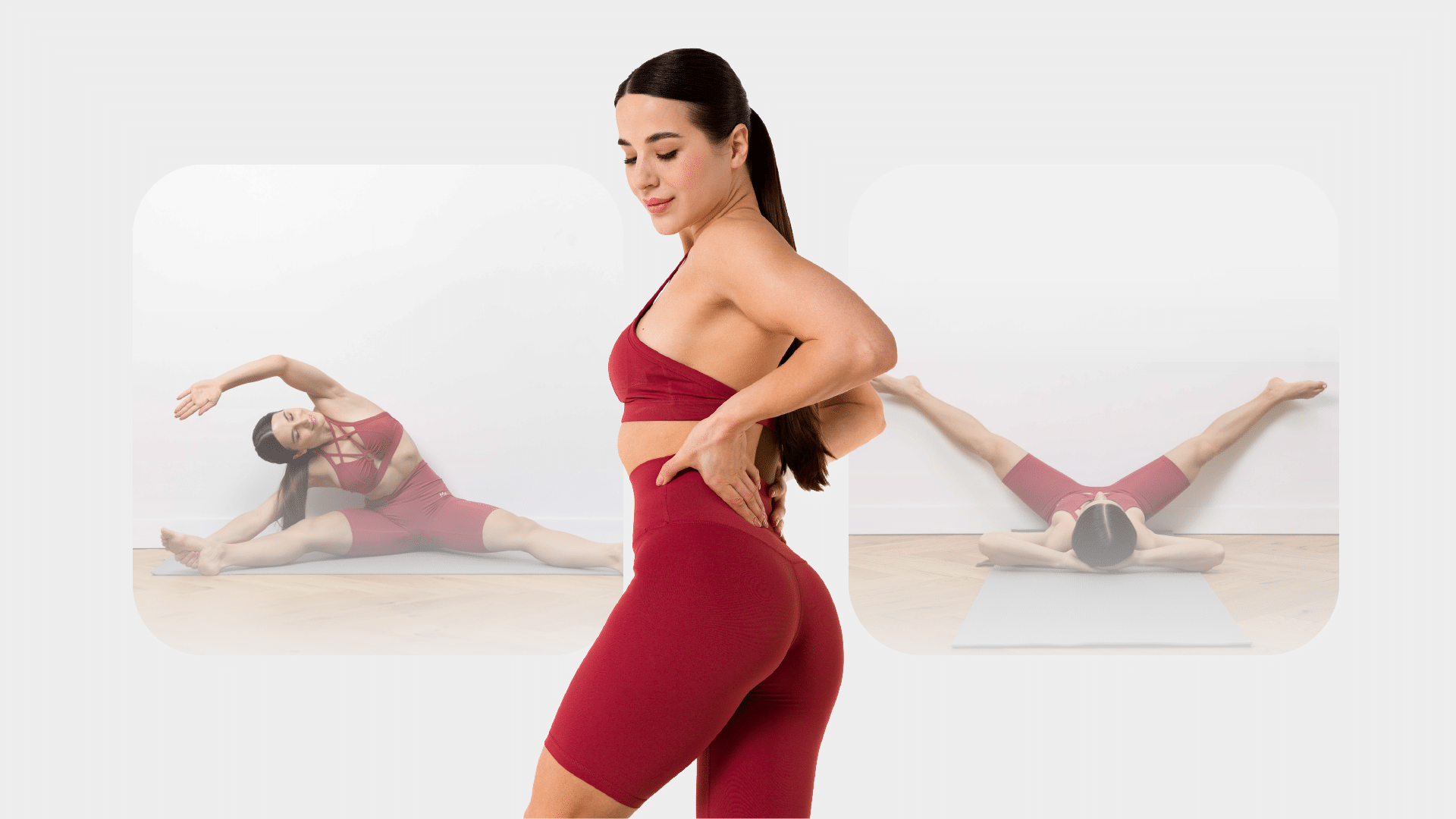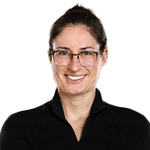Does Wall Pilates work, or are you falling for another TikTok exercise hype? You can’t scroll for five minutes without seeing someone using a wall to do Pilates. You wonder whether it’s effective as an exercise. Can Wall Pilates benefit your journey to fitness and weight loss?
Fortunately, you’ll find all the answers here. Wall Pilates is an effective core and glute activator. It can also improve posture, help you maintain balance during more challenging Pilates exercises, and help beginners establish proper form. Let’s show you how.
Is Wall Pilates Worth the Hype?
Wall pilates is effective and can help you because the exercises may:
- Offer similar benefits as Reformer Pilates but costs nothing (15)
- Provide a safe, low-impact method of exercise (14)
- Strengthen and stabilize the core (7)
- Improve posture and alignment (3)
- Enhance flexibility (16)
- Reduce pain and muscle tension (16)
- Tone and strengthen abdominal muscles (8)
- Be ideal for beginners (7)
- Help you lose weight (2, 6)
Wall Pilates Benefits You Must Know
Wall Pilates results make it worth the hype and more. Pilates is long touted as a low-impact exercise that can help you improve core flexibility and strength and gain sculpted muscle tone (11). However, what makes Wall Pilates such a hype this year?
Wall Pilates is the free sibling compared to using a Pilates reformer, the much more expensive option (15). Wall Pilates adds more resistance as the reformer increases resistance. It’s a free, added-resistance bodyweight workout to use at home.
You can add resistance bands, balls, and weights. However, Wall Pilates is entirely cost-effective and comes with many other benefits.
Wall Pilates May Stabilize and Strengthen the Core
Heather Milton from NYU Langone Health’s Sports Performance Center told Today that Wall Pilates is isometric training (14). Isometric exercises involve static muscle contractions, where the muscle length remains the same, and there is no joint movement. This allows you to contract specific muscle groups without placing excessive stress or movement on a joint.
Wall Pilates isolates the core and glute muscles for a total core activation. The Mayo Clinic confirms that isometric exercises such as those inWall Pilates may enhance the stability of core muscles by holding the position without affecting the surrounding areas (7).
If you struggle to even flirt with the idea of giving up your favorite foods or working out till your legs give way – BetterMe app is here to breathe a fresh perspective into the way you view the weight loss process! Check out the app and experience the fun side of fitness and dieting with BetterMe!
Wall Pilates May Improve Posture
Japanese researchers examined whether a 4-week core strengthening program could improve posture in 24 students (3). The results displayed that core strength training influences core stability, which plays an important role in posture and, more specifically, dynamic changes in balance.
The wall can help align your body, whereas traditional Pilates may require practice to master the principles. Regular Pilates requires concentration, breathwork, core activation, control, precision, and flow. The wall helps with these principles before you master them.
Wall Pilates May Enhance Flexibility Safely
WebMD focuses on the legs-up-the-wall exercise, revealing how the wall’s assistance can help relieve stress and tension in the body, alleviate fatigued legs, and help relieve lower body cramps (16). It can help to relieve tension due to the position it uses on the wall to support better alignment.
You may also relieve stress while enhancing your flexibility. The Mayo Clinic further suggests that isometric-style workouts may pose a smaller risk of injury (7). People with arthritis use isometric exercises to strengthen muscles without hurting the nearby joints.
Ultimately, people with injuries can safely use Wall Pilates as an isometric workout to avoid pain and reduce the risk of further injury while recovering.
Wall Pilates May Improve Form and Muscle Strength
WebMD shares the benefits of glute bridges, also focusing on elevated glute bridges, resembling the exercise against a wall (4). Wall glute bridges are a favorite to target the hips, core, glutes, and hamstrings. Pushing your feet into the wall is like elevated variations.
You can add more resistance and engage the glutes more than you would with regular glute bridges when using a wall. Meanwhile, the wall can enhance stability more than using a ball or item that easily slips out from under you while exercising.
Does Wall Pilates Reduce Belly Fat?
Using targeted exercises to burn belly fat is not effective. Losing total body fat requires a consistent calorie deficit that can be achieved with a nutritious diet and regular exercise routine. However, a Spanish study which involved pilates training showed that regular pilates practice can improve and increase muscular hypertrophy in abdominal muscles (8).
Pilates is about core activation, and it tones and sculpts the obliques, tranversus abdominus, and rectus abdominus muscles. To effectively lose weight you can include a combination of cardio and strength training activities, maintain a calorie deficit, and incorporate regular Wall Pilates to target core strength.
Bonus: Wall Pilates for Beginners
Wall Pilates is ideal for beginners because it offers support and resistance, with a lower risk of injury while you learn how to balance correctly in Pilates exercises (7). It also provides core and spine stability for those who haven’t worked out long.
Furthermore, the Hundreds Pilates exercise is a full-body workout typically done on a reformer to master the necessary balance (9). However, resting your feet against the wall can help beginners master this seemingly impossible balancing act by anchoring your body.
How Long Does It Take to See Results From Wall Pilates?
The Japanese research showed core strength and stability improvements after four weeks of core strength training (3). If you commit to a well-developed pilates program incorporating key exercises, four weeks can be enough to see results from your Wall Pilates workout plan.
Is Wall Pilates Better Than Regular Pilates?
Wall Pilates can be a better option than regular Pilates for beginners and those with arthritis, injuries, and painful joints. (7). It can be a suitable starting point for beginners as the added resistance from the wall against your body weight can help strengthen muscles more than traditional variations of some exercises (4). Still, well-trained individuals may prefer normal Pilates.
Read more: 6 Wall Pilates Ab Workout Exercises You Should Include In Your Routine
Does Wall Pilates Work? Recommendations for Results
Wall pilates results are unsurprisingly in favor of the hype on FitTok. Still, following the right workout plan with Wall Pilates exercises to target different areas will bring the best results.
How Many Times a Week Should You Do Wall Pilates?
The best Wall Pilates app will guide you with expert advice and workout plans to ensure you do the exercises as often as necessary. Our Pilates Wall program will collect your essential information, depending on your gender, goals, and more.
However, you should follow a Wall Pilates workout plan that has you actively doing exercises at least 3-4 times weekly. Also, add cardio to your routine, possibly alternating days for cardio and Wall Pilates to lose weight (2). A calorie deficit is also vital to weight loss (6).
Check these out for more of our Wall Pilates guidance:
Best Wall Pilates Workout
The proper wall pilates workout targets various parts of your body. The best exercise follows the Mayo Clinic recommendations for 12-15 reps and at least one set (12). Use the recommended reps to complete two sets of the five Wall Pilates exercises to see core, upper, and lower body results.
5 Wall Pilates Exercises
Wall Pilates exercises are suitable for beginners, those recovering from injuries, or anyone seeking core strength. It helps to perform a dynamic warm-up before starting the practices. Stretch out and do arm circles for 2-3 minutes to prepare your body. Here are the exercises:
Glute Bridge
The glute bridge against the wall can activate and strengthen the glutes, core, and hamstrings potentially more than the typical exercise because you elevate your feet (4). By pushing your body weight against the wall, you create an increased resistance, which can further increase muscle activation.
- Place your bum a few inches from the wall as you lie flat,
- Bend your knees while pushing your feet into the wall,
- Balance on your upper back while raising your glutes off the floor,
- Squeeze the glutes tight for five seconds,
- Control your return to the mat while breathing evenly.
Hundreds
The Hundreds Pilates exercise is a balancing act of note. However, Livestrong says this exercise can work muscles in your upper and lower body as well , and help strengthen the abdominal wall (9).
- Lie flat close to the wall with your knees slightly bent and elevated,
- Get into a tabletop position by raising your neck toward your chest,
- Keep your arms along your body while holding your legs and neck in the air,
- Stop immediately if you push your neck too far,
- Gently rest your feet against the wall for support,
- Focus on breathing as you hold the position for five seconds.
Wall Plank
The wall plank exercise can target your lower back, glutes, obliques, abdominals, core, and shoulders (5). You won’t have as much resistance against the shoulder muscles as you do with traditional planks, but this variation is easier to hold for longer.
- Face the wall with bent elbows, touching the wall with your forearms,
- Your elbows must be shoulder-height and the forearms in front of your face,
- Squeeze your shoulders as you lean into the forearms with your upper body,
- Keep your body in a straight line while walking your feet backward,
- Keep the straight line for 15-20 seconds per rep.
Wall Squats
The New York Times suggests that isometric exercises such as wall squats may help lower blood pressure (1). Wow! You’re targeting muscles and fighting hypertension with the final Wall Pilates exercise. Meanwhile, you’re working those glutes, hamstrings, calves, thighs, and pelvic muscles.
- Stand facing away from the wall with your feet about one foot away from it,
- Lean your back, hips, and shoulders against the wall,
- Hang your arms down your sides with your palms against the wall,
- Bend your knees and control the slide down the wall into a squat position,
- Your thighs will be parallel to the floor,
- Raise your arms to be parallel with the floor during the squat,
- Stay in this position while breathing evenly and counting until ten,
- Rise while resting your palms back against the wall.
Wall Angels
Finally, add wall angels to better target the upper back and shoulders for a full-body Wall Pilates workout. Wall angels can help strengthen the chest, trunk, upper back, and shoulder muscles while giving your core a milder workout (13).
- Stand with your back flush against the wall, keeping your arms rested by your sides,
- Slowly raise your arms outward and overhead until your hands touch,
- Your arms must never leave the wall, like making a snow angel on the wall,
- Hold your arms aloft for 15-20 seconds and lower them slowly.
Whether you’re a workout beast or just a beginner making your first foray into the world of fitness and dieting – BetterMe has a lot to offer to both newbies and experts! Install the app and experience the versatility first-hand!
FAQs
Is 20 Minutes of Pilates a Day Enough?
Twenty minutes daily can be enough for strength training. Pilates is a form of strength training using your body weight as resistance. The Mayo Clinic recommends 20-30 minutes of strength training 2-3 times weekly (12). Also, to rest muscles for a day between workouts. Extend the workout times by five minutes every second week as your body gets used to 20 minutes.
How Do You Know if Pilates is Working?
Your Wall Pilates workout works if you feel muscle fatigue and balance improvements. The Mayo Clinic says resistance or strength training that actively tires the targeted muscle group is effective (12). The Cleveland Clinic also recommends paying attention to balance and coordination because Pilates help strengthen the core (10).
How Effective is Wall Pilates for Weight Loss?
Wall Pilates for weight loss is effective with cardio and a consistent calorie deficit. Beaumont Health says cardio and strength training burn calories (2). Wall Pilates is a form of resistance/strength training. Meanwhile, Medical News Today states that the most effective way to lose weight is to maintain a consistent calorie deficit (6). So, combine the three strategies for effective weight loss.
The Bottom Line
Does Wall Pilates work? Yes! Wall Pilates is worth every moment of hype on FitTok. The benefits include injury recovery, muscle sculpting, and core stability for beginners. Use the Wall Pilates exercises above, or join our app to start our program today.
DISCLAIMER:
This article is intended for general informational purposes only and does not address individual circumstances. It is not a substitute for professional advice or help and should not be relied on to make decisions of any kind. Any action you take upon the information presented in this article is strictly at your own risk and responsibility!
SOURCES:
- A Simple 14-Minute Workout That Could Lower Your Blood Pressure (2023, nytimes.com)
- Cardiovascular Training vs. Strength Training (n.d., beaumont.org)
- Effects of Core Strength Training on Core Stability (2018, ncbi.nlm.nih.gov)
- How to Do a Glute Bridge (2022, webmd.com)
- How to Perform the Wall Plank Exercise (n.d., physitrack.com)
- How to Safely and Efficiently Create a Calorie Deficit for Weight Loss (2023, medicalnewstoday.com)
- Isometric Exercises? Good for Strength Training? (2022, mayoclinic.org)
- Marked Effects of Pilates on the Abdominal Muscles: A Longitudinal Magnetic Resonance Imaging Study (2012, pubmed.ncbi.nlm.nih.gov)
- Pilates Hundred Exercise: How to Do It, Benefits, and Variations (2023, livestrong.com)
- Pilates: What It Is, and Health Benefits (2023, health.clevelandclinic.org)
- Pilates: What It Is, Benefits, and More (2023, webmd.com)
- Strength Training: Get Stronger, Leaner, Healthier (2023, mayclinic.org)
- Wall Angels is One of the Best Posture Exercises You Can Do (2021, healthline.com)
- Wall Pilates is the Latest Workout Trend Delivering Impressive Results: Try it With These 3 Exercises (2023, today.com)
- What Is the Pilates Reformer: Benefits, and How to Use (2022, verywellfit.com)
- What to Know About Legs-Up-the-Wall Yoga Pose (2021, webmd.com)

